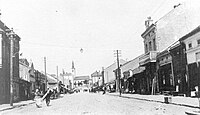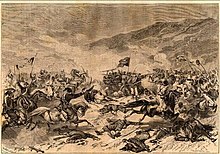Aleksinac
Aleksinac
Алексинац (Serbian) | ||
|---|---|---|
Town and municipality | ||
 Church of St Nicholas, Aleksinac | ||
|
Car plates AL | | |
| Website | www | |
Aleksinac (Serbian Cyrillic: Алексинац) is a town and municipality located in the Nišava District of southern Serbia. According to 2022 census, the municipality has a population of 43,258 inhabitants.
History
Prehistory and Antiquity
The territory of the municipality of Aleksinac has been inhabited since the neolithic age. Most of the settlements in the area belong to the Vinča cultural group, and are located on the western side of the South Morava river.
After the fall to the
Their location is still unknown, although there are few candidates for this position. Also few fortresses (Castell) are known to existed in this period, but their names are not known, except for the Castell Milareca on Gradiste hill (228 m).
Middle Ages
From the year 476 this territory was under
During the reigns of emperors
During the reign of the
, date from this period.Ottoman rule

Aleksinac is first mentioned in 1516 in "Kruševački Tefter", a list of towns and its residents were made by Turks to keep an eye on taxes, as the village belonging to Bovan province and Kruševac sanjak. It remained village up to the end of the 16th century when it was developed into town settlement.
In the middle of the 17th century, Aleksinac was town with more than 100 shops in it, and because of its strategic location on the road to
The development of Aleksinac was stopped during the so-called
After the third Austro-Turkish War (1737–1739) Aleksinac developed into significant trade and handcraft center. Many caravans passed through it exchanging wares from entire Ottoman Empire and central Europe. At the same time it became center of Aleksinac county which in 1784 consisted of 17 villages. There were 160 houses in Aleksinac at that time, 120 of them Christian and 40 Turkish.
After the fourth
Modern times

Aleksinac and its surrounding area joined the First Serbian Uprising in January 1806. This included villages on the right bank of the South Morava river which were liberated by the army of Petar Dobrnjac.
The settlements on the left bank were liberated by Mladen Milovanović and Stanoje Glavaš. As soon as the town was liberated, Captain Vuča Žikić built the famous Deligrad trenches on the north side of Aleksinac which earned fame in battles with the Turks, especially in 1806.
After the fall on the First Serbian Uprising, Aleksinac remained under Turkish rule up to December 1832 when it became integral part of
It became a centre of county and county court. The third post office in Serbia (after Belgrade and Kragujevac) was opened in Aleksinac for both Serbian and Austrian post as well as the place where English courier sent and received the post from Turkey. At that time Customs office and quarantine station were built in Aleksinac.
Aleksinac was also the site of major battles with
Aleksinac was seriously damaged during the
Settlements
Aside from the town of Aleksinac, the municipality includes the following settlements:
- Aleksinački Bujmir
- Aleksinački Rudnik
- Bankovac
- Beli Breg
- Belja
- Bobovište
- Bovan
- Bradarac
- Vakup
- Veliki Drenovac
- Vitkovac
- Vrelo
- Vrćenovica
- Vukanja
- Vukašinovac
- Glogovica
- Golešnica
- Gornja Peščanica
- Gornje Suhotno
- Gornji Adrovac
- Gornji Krupac
- Gornji Ljubeš
- Gredetin
- Grejač
- Dašnica
- Deligrad
- Dobrujevac
- Donja Peščanica
- Donje Suhotno
- Donji Adrovac
- Donji Krupac
- Donji Ljubeš
- Draževac
- Žitkovac
- Jakovlje
- Jasenje
- Kamenica
- Katun
- Koprivnica
- Korman
- Kraljevo
- Krušje
- Kulina
- Lipovac
- Loznac
- Loćika
- Lužane
- Ljupten
- Mali Drenovac
- Mozgovo
- Moravac
- Moravski Bujmir
- Nozrina
- Porodin
- Prekonozi
- Prćilovica
- Prugovac
- Radevce
- Rsovac
- Rutevac
- Srezovac
- Stanci
- Stublina
- Subotinac
- Tešica
- Trnjane
- Ćićina
- Crna Bara
- Česta
- Čukurovac
- Šurić
Demographics
| Year | Pop. | ±% p.a. |
|---|---|---|
| 1948 | 61,002 | — |
| 1953 | 64,344 | +1.07% |
| 1961 | 67,200 | +0.54% |
| 1971 | 66,082 | −0.17% |
| 1981 | 67,286 | +0.18% |
| 1991 | 63,844 | −0.52% |
| 2002 | 57,749 | −0.91% |
| 2011 | 51,863 | −1.19% |
| Source: [3] | ||
According to the last official census done in 2011, the municipality of Aleksinac has 51,863 inhabitants.[4]
Ethnic groups
The ethnic composition of the municipality:[4]
| Ethnic group | Population | % |
|---|---|---|
| Serbs | 47,563 | 91.71% |
| Roma | 1,937 | 3.73% |
| Macedonians | 98 | 0.19% |
| Montenegrins | 68 | 0.13% |
| Croats | 50 | 0.10% |
| Yugoslavs | 49 | 0.09% |
| Bulgarians | 45 | 0.09% |
Muslims |
37 | 0.07% |
Slovenians |
30 | 0.06% |
| Vlachs | 21 | 0.04% |
Romanians |
20 | 0.04% |
| Albanians | 18 | 0.03% |
Hungarians |
16 | 0.03% |
| Russians | 15 | 0.03% |
| Gorani | 13 | 0.03% |
| Others | 1,883 | 3.63% |
| Total | 51,863 |
Economy
The following table gives a preview of total number of registered people employed in legal entities per their core activity (as of 2018):[5]
| Activity | Total |
|---|---|
| Agriculture, forestry and fishing | 111 |
| Mining and quarrying | 327 |
| Manufacturing | 3,026 |
| Electricity, gas, steam and air conditioning supply | 30 |
| Water supply; sewerage, waste management and remediation activities | 274 |
| Construction | 205 |
| Wholesale and retail trade, repair of motor vehicles and motorcycles | 1,191 |
| Transportation and storage | 271 |
| Accommodation and food services | 289 |
| Information and communication | 62 |
| Financial and insurance activities | 82 |
| Real estate activities | 3 |
| Professional, scientific and technical activities | 214 |
| Administrative and support service activities | 71 |
| Public administration and defense; compulsory social security | 457 |
| Education | 838 |
| Human health and social work activities | 985 |
| Arts, entertainment and recreation | 86 |
| Other service activities | 139 |
| Individual agricultural workers | 819 |
| Total | 9,482 |
Tourism
Lake Bovan, situated 15 km from Aleksinac centre, is a place popular for tourists. The medieval monastery from the 15th century built by Despot Stefan Lazarević, St. Stefan in Lipovac, is 25 km from the city. The monastery is built beneath the slopes of Mt. Ozren (1175 m). There is also remnants of two medieval towns in the mountains surrounding Aleksinac: Bovan and Lipovac, however they are not well preserved.
-
Bovan lake
-
Ozrenmountain
-
European highway E75
-
Mali Jastrebac
-
Aleksinac
-
Aleksinac valley
Notable people
- Kosta Taušanović (1854–1902), one of the founders of Serbian Radical Party, minister of police and minister of commerce, founder of first insurance company in Serbia.
- .
- Mihailo Gavrilović (1868–1924) prominent Serbian historian and diplomat.
- Dragutin Jovanović-Lune (1892–1932), Serbian guerrilla fighter, officer, politician, delegate and mayor of Vrnjci. He was awarded several times for his service in the Balkan Wars and World War I.
- Dejan StojanovicSerbian musician, prominent guitar player.
Trivia
- The patron saint of Aleksinac is St. Mark.
- Aleksinac was the first Serbian town to get a post office, on May 25, 1840. The second was opened in Belgrade and the third in Kragujevac.
- Aleksinac is the home of the Native Indians Society of Serbia.
Twin towns – sister cities
 Aiani, Greece
Aiani, Greece Hisarya, Bulgaria
Hisarya, Bulgaria- Laurium, Greece
 Probištip, North Macedonia
Probištip, North Macedonia Zagorje ob Savi, Slovenia
Zagorje ob Savi, Slovenia
References and further reading
- ^ "Municipalities of Serbia, 2006". Statistical Office of Serbia. Retrieved 2010-11-28.
- ^ "Serbian census 2022" (PDF). Републички завод за статистику Србије. Републички завод за статистику. Retrieved 30 December 2023.
- ^ "2011 Census of Population, Households and Dwellings in the Republic of Serbia" (PDF). stat.gov.rs. Statistical Office of the Republic of Serbia. Retrieved 16 February 2018.
- ^ a b "ETHNICITY Data by municipalities and cities" (PDF). stat.gov.rs. Statistical Office of Serbia. Retrieved 16 February 2018.
- ^ "MUNICIPALITIES AND REGIONS OF THE REPUBLIC OF SERBIA, 2019" (PDF). stat.gov.rs. Statistical Office of the Republic of Serbia. 25 December 2019. Retrieved 28 December 2019.
- ^ "Ministar Ružić i predstavnici iz Grčke, Slovenije, Bugarske, Makedonije i Rusije na proslavi Dana opštine Aleksinac". alpress.rs (in Serbian). AlPress. 2018-06-05. Retrieved 2021-01-19.
- Istorija Aleksinca i okoline do kraja prve vladavine kneza Miloša, Sprić Miodrag, Aleksinac, 1995.
- Aleksinac i okolina, Dr. Branko Peruničić, Beograd, 1978.









